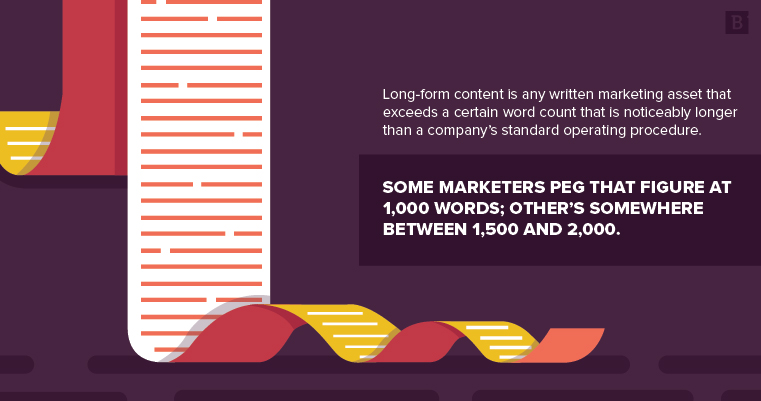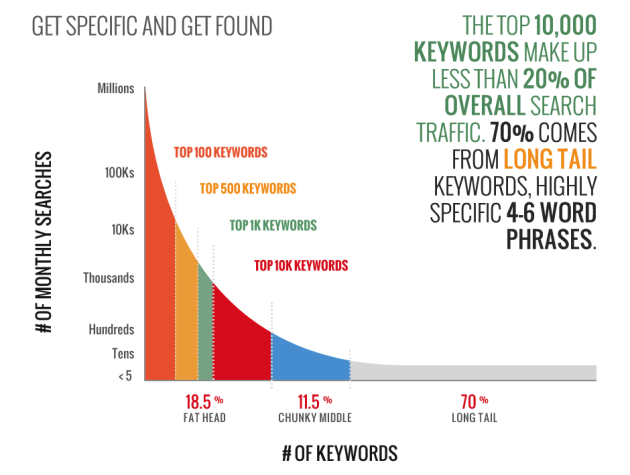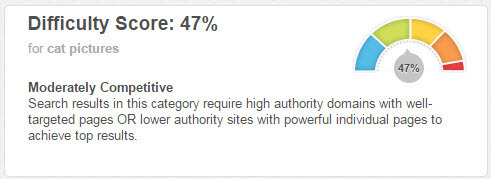Long-form content takes many, well, forms.
In 1913, French novelist Marcel Proust began publishing what is still considered to be the longest novel of all time, a multivolume epic titled, “À la recherche du temps perdu,” or, in English, “In Search of Lost Time.”
In total, Proust registered 4,215 pages written, or 1,267,069 words.
American author, and founder of the Church of Scientology, L Ron Hubbard holds the title of “Most Prolific Writer in History,” publishing 1,084 distinct books. He was also known to produce 100,000 words per month during his more inventive years (that’s about one novel every 30 days).
In content marketing, this output would be overkill.
Among us present-day digital folks, long-form content has a more germane definition.
What is long-form content?
Long-form content is any written marketing asset that exceeds a certain word count that is noticeably longer than a company’s standard operating procedure.

Some marketers peg that figure at 1,000 words; other’s somewhere between 1,500 and 2,000.
For the purpose of this post, we’ll push that number to 3,000.
On average, the majority of our blog posts at Brafton fall in the 1,800-word realm, so this is a subjective, internal understanding we use. However, we allow the research, the story and the competitive ranking opportunities dictate final word count. You should, too
Longer content should always serve a larger goal, and it should never be produced for the sake of hitting a certain word count or for fulfilling a quota.
Function and form: Short versus long content
Relative to short-form content (we’ll say anything under 1,000 words), long-form is an inherently unique specimen.
It isn’t ad copy or meant to be catchy. It’s the opposite.
Long-form content is intended to be the most comprehensive, useful asset you produce, something that answers every relevant question a searcher may have on a given topic. And that’s why posts err on the longer side – not because of verbosity but because of intent.
There’s no way to discuss the historiography of the Bronze Age in a 500-word listicle without doing a severe disservice to the reader and your reputation.
Each piece of content you create, regardless of its size, should do justice to the topic itself – and remember, you’re competing with the entire internet every time you open your content management system and start typing. In both form and function, longer content often means better content.
The blog: Long-form content’s ideal medium
By “long” and “form” we’re typically referring to the trusty blog post.
Sure, eBooks and white papers can run 3,000 words and longer (to infinity!), but those assets serve a reader at a different point in the funnel. Plus, eBooks and white papers are normally gated as PDFs behind form fills, making them less easily crawled by search bots and not the average person’s ideal format for being first introduced to a topic.
If someone loves a blog post and wants to know more, THEN they might move toward a white paper for even greater depth on the topic at hand. But a blog post, first and foremost, is a top-of-funnel asset that is often the initial interaction site visitors have with a brand, and it also feeds search engines with comprehensive, indexable content to position in SERPs.
Without long-form blogs, SERPs would be quite bare and uninteresting.
Other marketing materials like case studies, videos and graphics aren’t what you would consider long-form vehicles, either.
Case studies may or may not be gated, but regardless, they often contain formatting and customer testimonials, meaning they’re for bottom-of-the-funnel conversations, not search-indexed SERP visibility.
Videos, even loooonnggg videos, aren’t traditional long-form pieces of content, as without accompanying text, they serve users who only intend to visually consume content, which likely isn’t the case for visitors to a corporate website.
On the design side, graphics are, by definition, meant to be consumed within a matter of seconds – that’s how the brain works. Readers aren’t supposed to pore over the contents of an infographic as they would a long blog post.
How long-form content fits into your content marketing strategy
One could argue that shorter – dare I say it – snackable content has its place. Fair enough. But long-form content needs a dedicated space within every content marketing strategy – yes, every single one.
What you’re able to accomplish via well-written, topically dense blog posts is a level of authority and sophistication that both humans and search engines reward. And every brand has a story to tell. Lots of stories, in fact.
If I run a cloud-enabled business in the logistics space, I have a lot of information I need to convey to site visitors. We’re not talking about how to make a PBJ sandwich here; we’re talking about the intricacies of a highly variable industry and the applications that make possible the success of multibillion dollar enterprises across the globe. That takes time, subject matter expertise and plenty of research. Oh, and data. Disgusting amounts of data.
Your content marketing strategy requires extensive commitment to this level of detail should you seek to propel your site to the top of SERPs, answer customer questions and develop industry influence.
Subject matter
Who knows more about your industry than you do? Well, there may be some savants out there that do, but can they explain it as well as you? Can they position your value props better than you can?
Long-form content is your company’s chance to dominate a given subject matter in a way that adds value to readers.

You already have the experts on staff, and by pairing them with capable writers, you can create content that serves the full interest and intent of your audience, which may be highly niche.
Picking your topic
But just because you have SME in your field, and maybe even a content agency at your disposal, how do you know which topics work best in longer form?
- Your agency should be able to answer this. If not, get a new agency.
- Allow your current organic positioning, Keyword Difficulty and commercial search value dictate which topics are most worth pursuing and how long they should be.
Tools like SEMrush and MarketMuse can help you identify gaps in your existing content that equip you with the primary, secondary and tertiary information needed to elongate shorter posts. Additionally, you can create content from scratch by evaluating the competitive SERP landscape of your high-value queries (and their semantically related topics), which sheds light on the topics others aren’t writing successfully – this is your chance to one-up them.
Potential challenges to overcome
Content creation isn’t a silver bullet, especially if it’s done incompletely or with flawed information. But longer content stands above shorter posts in terms of its potential risk/reward spectrum.
The risks often include:
Attention span
If you write 2,000 words of excellent content, you still need to retain the attention of your audience for long enough to keep them engaged all the way through the post.
That’s not easy.
Our attention spans are trending downward, now just 8 seconds long. In that amount of time, a reader can process maybe a sentence or two, and who knows whether he or she will actually understand what was just read.
To avoid drooping eyelids, augment your lengthy copy with other forms of media, like YouTube embeds, .gifs, social media callouts and various design features.
Time to read
The actual length of time spent consuming your content is another factor to consider.
Long posts require diligent readers, and some site visitors simply will not commit to any form of media that requires several scrolls of their touchscreens or a solid 10 minutes out of their commute.
Time-to-read meters are now commonplace atop web pages, enabling readers to see right away how long it will take them to fully consume the information at hand. This could be a deterrent or an incentive.
Six-time World Champion Speed Reader Anne Jones blazed through Harry Potter and the Deathly Hallows in 47 minutes, consuming information at 4,251 words per minute.
The average person is not Anne Jones. In fact, you and I are about 1/14th the reader Anne Jones is – our words-per-minute calculation is a casual 300.

That gives a 2,000-word blog post a time-to-read score of about six or seven minutes. Can you hook readers in this time frame?
Resource availability
On the front end, it’s possible you may not even have the talent, time or money to produce content that is more labor intensive. Plus, if you have a smallish marketing budget, can you justify devoting a large chunk of your spend toward just a handful of assets, as opposed to disseminating a greater number of posts which may be on the short end?
It goes back to quality versus quantity. Without knowing the ROI of a long blog post beforehand, it’s tough to allocate resources accordingly.
Target audience
If you have great topics, top-notch writers and plenty of keyword research in your backpocket, what happens if your target audience simply does not prefer long work?
You can lead a horse to water, but you can’t make him drink (other cliches pertinent here as well).
But it’s true.
If you’ve conducted detailed persona mapping, have the metrics to show your target audience’s lack of engagement and are mighty familiar with their reading habits, then don’t force it. The one thing we can say is that, poor engagement could be a sign of poorly structured articles, not an indication of your readers’ waning commitment to your brand or your content.
Continually A/B test your content to see what sticks and what’s worth more investment.
The case for long-form content: A search engine’s dream
Now, even if long-form content has its detractors, there’s no arguing the fact that search engines universally reward web pages on the lengthier side.
To be clear: This is not a statement of high word count = high organic ranking.
Rather, this is a testimony to the empirical ranking algorithms search engines use. High word count is a byproduct of comprehensive, authoritative content; it’s not the cause.
Following this line of thinking, it’s clear that the sheer level of noise on the web makes it imperative to push down thin content in SERPs by replacing it with content that is categorically valuable and relevant to users based on their search intent. More often than not, what can be explained in 500 words is not going to be of greater value to a searcher if he or she is aware that there is information on the same topic that is 3,000 words long and answers every single follow-up question.

Don’t think you can ramble your way into Position Zero, either. Google’s RankBrain algorithm is engineered to continuously mine search results and penalize those that don’t serve user intent. Your content may have been passable a few years ago (even a few weeks ago), but as soon as RankBrain re-evaluates your page’s updated click-through rate and dwell time, it judges anew the true value of your page.
Quality, evergreen content hedges against being penalized by Google, so it’s safer to make an investment in lengthy posts now than it is to try and outsmart search engines or shortchange readers because of preconceived notions or lack of marketing know-how.
Take our word for it via this case study we published on Moz.
Optimizing long blog posts for organic ranking
The great part about crafting killer content that meets the needs of search engines is that the ordinary website likely already has existing content on its site that can be improved upon.
This means you’re already in field-goal range of registering a big win.
To obtain every last drop of SEO value from your content, there are a number of factors to keep front of mind. At Brafton, we optimize our pages to better address content gaps and to outperform competitors who are ranking ahead of us. Keep your URL the same – just update the content.
Long-tail keywords
Keywords are, of course, important. But don’t think of them simply as phrases you need to repeat back to your reader. These terms are actually topics with intent behind them, and they need to be explored in enough detail to answer questions searchers have.
Based on Keyword Difficulty and your overarching goals, your high-value keywords are likely those that are commercially driven, or at least map to your marketing campaigns.

Long-tail keywords, specifically, afford you the opportunity to record quick wins in the blogosphere, as they tend to have lowish search volume but high intent. Using longer tail keywords as a starting point, you essentially prequalify site visitors and ensure the primary audience finding you in search results is one that is highly interested in your products and services – spammy, low-intent traffic, be damned.
Topical authority
Long-form content similarly serves as a launchpad for expounding on the ideas, trends and issues your industry faces. Optimizing your blog posts to singularly focus on an important topic keeps your writing geared toward what counts: being the best possible result for a searcher.
Topical authority is exactly what it sounds like: You are the mecca of all things tied to a topic, and searchers know precisely where to go should they need information in the future.
Cover a single topic from every angle as completely as possible – that’s what high-ranking content is in 2018.
Search relevance
Writing long-form content is only worthwhile if it actually serves the decisions searchers make. If no one is querying about a certain topic, don’t write about it. Among every SERP, there is a range of relevance to users.
Some results do a good job at completely matching search intent, and others are only tangentially relevant.
Long-form content should originate from this concept of relevance. Your primary argument, your subheads, your keyword usage, etc., should be constructed with the goal of being more relevant and informative than the other listings that show up in Google.
User experience
As discussed earlier, reader attention is a prized commodity. With long blogs comes the risk of poor UX habits coming into greater focus.
Keep paragraphs short, your ideas linear and your media embeds logical. Before posting your content, assess it from a reader’s standpoint. In which section does your story start to peter out? Are their native ads that are actually disruptive or confusing? Are you using interstitials that are covering the text?
Dwell time
Dwell time measures the amount of time a user spends on a search result before clicking the back button to head back to SERPs. A higher score is better. A low score indicates users did not find what they were looking for, and they’ve returned to Google to find something that does.
This is long-form content’s wheelhouse. In-depth posts stand a better chance of answering searcher questions, thus keeping users on the page (or incentivizing them to click through other posts on your site). Thin content does not have this advantage, as it’s likely that there will always be a longer, more informative post on the web that more closely serves their intent.
Keyword Difficulty
To capitalize on the editorial resources you have, write long posts around search terms that actually have achievable Keyword Difficulty scores.
If a term is too competitive for your brand, you could be flushing content down the toilet – it’ll never appear high enough in SERPs to pay off. On the other hand, Keyword Difficulty scores that reveal real opportunities to rank for a term should be pursued.

Build your long-form strategy around this premise.
Promoting long-form content on social media
Part of getting the most out of your marketing team is to amplify content for greater reach.
Over time, strong social signals can lead to more link-building opportunities and push your content higher in SERPs.
Social shares
Sharing your content across the social channels that are most frequented by your audience is a must. For B2B marketers, this often means LinkedIn and Twitter. In 2018, one of the top B2B trends is consolidating social spend into single, proven platforms instead of dividing up social activity across a number of channels. See how this tactic treats you.
For more conversational B2C companies, Instagram and Facebook may prove more resourceful.
Share your content accordingly, but also, incentivize your followers to reshare as well.
Engagement
In addition to being shareable, your content should provoke responses, comments, likes, upvotes, emoji reactions, reviews and other commentary.
These interactions show that followers are actually engaging with your work. If you receive an enormous groundswell of negative or positive feedback on social media, factor this into subsequent posts.
Distribution, syndication and amplification opportunities
Long-form content can also be optimized for exposure beyond your own website and social channels.
Guest-posting on high-profile platforms, syndicating your work through relevant publications and building a rapport with industry influencers are go-to tactics.
If you’ve produced high-quality content, your brand has inherent value. If you can position that value to other companies and audiences through promotion efforts, then you’re one step closer to more traffic, more leads and more followers.
Medium, LinkedIn Pulse, Business 2 Community and PRNewsWire are all common outlets that can amplify and distribute your blogs to new markets.
Conclusion
Not all content is created equal.
Search engines are continuously updated to prove as much.
As the average length of blog posts rises over time, the benchmark for what is considered “long” increases as well. But this metric is somewhat skewed.
You can rank on page one of Google with just 400 words for some terms, but it may take 4,000 for another.
It’s the value you provide within this word parameter that sets content apart, however. Never skimp on quality, and always prioritize user relevance. From there, let the words fall how they may.





